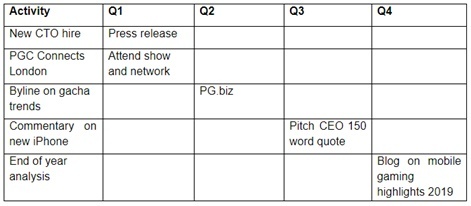Rana Rahman is the founder of Raptor PR.
PR and publicity can provide incredible value for organisations in the mobile gaming world. It can be a cost-effective way for companies to help position themselves, raise awareness of talent, products and services, and voice strong opinions across gaming and business media sectors.
If you’re seeking external investment, it’s often a prerequisite to include recent media coverage from trustworthy and respected media sources.
There’s no reason why game developers and tech companies can’t do some ‘in-house’ PR effectively. However, you do need some essential resources: talent (a good writer would help, someone who thrives on news), and most of all, some time to develop a sound PR plan with actionable tactics. If you have these elements, then let’s kick-off!
Gaming PR can be split into two halves: consumer PR and business PR.
This particular article focuses on the latter. Business PR, also known as games trade PR, is a powerful tool for organisations to gain a clear voice in the market and to help communicate your company’s ‘positioning’ and tell its story.
Games trade PR should be tightly woven into your business strategy, as it is key to create a personality or brand around senior company talent, the company and its products and services.
Your narrative is defined by your unique journey and accompanying stories. Communicating your successes and innovations helps to show how good you are to prospective developers and publishers.
The Games Trade PR Tool Kit for beginners
Step one: The discovery phase
Conduct a desktop ‘media audit’ around your company and industry. Understand your media profile and the universe of news content and topics which surrounds your company.
Also check out what your competition is doing in the news. I’d personally recommend conducting a news search on a similar game, or service, and see what types of stories and issues are prominent.
This information harvesting phase is to enable you to gather your data around your game genre, company type (e.g. hyper-casual game developer, ASO analytics firm, mobile AR game specialist) and bring the data to life in a creative and meaningful way, therefore bringing your target audiences to life.
Step two: The PR plan
You know your business objectives. Now create a PR plan to support the delivery of your business objectives. Your strategy is the link between your business goals and its communications. It should be a short, concise articulation of intent of what it will take to meet your business objectives. Your PR strategy informs your ‘key messages’, voice and tactical executions.
Step three: Define your key messages
Every company has key PR messages. These could be two to three sentences, which carefully articulate what your company does, and its points of difference from competitors. They help to define your company. Often when evaluating KPIs such as media coverage hits, one parameter is to track if coverage includes key messaging within. Your branding and tone of voice also informs your messaging.
Example 1: Aadvark Games Ltd is a next-generation mixed reality games maker;
Example 2: Games Data Ltd is a leading games analytics company that delivers companies with vital data to empower strategic decision making.
Step 4: Critical timeline
Draw up an achievable timeline of planned activity based around your main business news beats. A big chunk of PR is project management, and being smart with time.
Here's a simple example:

Assets needed
You should have a company backgrounder or corporate press release boilerplate ready at all times. This is the blurb that sits at the bottom of a release. It’s an indispensable asset that can be used when pitching or selling stories to the media. Also, it’s prudent to have some bios written, especially for your C-Suite.
Media contacts and influencers
Start fostering relationships with journalists relevant to you, if you haven’t done so already. Let’s face it, trusted, good human relations always take time. Don’t spam or bombard journalists relentlessly. This will only piss them off.
If you’re attending Pocket Gamer Connects events, say hi to the news team. They’re always on the lookout for cool, new innovative companies with stories to tell. You could invest in a media database (e.g. Cision, Roxhill, PR Max, Agility). Or reputable PR agencies will (or should) have strong black books of hot contacts.
Your universe of business media and influencer contacts will likely encompass news websites (examples of sectors: games business, marketing, ad tech, blogs, entrepreneur, startup news, tech), Twitter, LinkedIn Groups, business sections of national and local newspapers.
Don’t spam or bombard journalists relentlessly. This will only piss them off.
This is all dependent on what kind of company you are in the mobile gaming world. Tailor your media targets based on your company interests.
Trends and hot blazing stories
Study trends relevant to your company, set up email alerts, follow journos on Twitter and LinkedIn groups. For example, what’s hot at the moment? Niantic’s latest Harry Potter AR venture. Do you have an opinion on it? Do you have the credibility to comment on it? Keep a firm eye on what your contemporaries and competitors are doing. Be inspired by companies with great PR platforms in action.
For example, there’s a great deal being written about subscription models right now. Could you comment or create news around this topic? Outputs could be an opinion piece, or offering targeted journalists with a soundbite of what you think about Google Stadia’s model and how it could benefit your business.
Thought leadership
Opinion pieces, also known as op-eds or thought leadership content, are a great way to deliver a steady cadence of smart thinking content across business media. Think about a series of articles, delivered say every three months, with a core gaming or business outlet.
The topics which you could write about are boundless. It could be something on how you have managed to maximise LTV in your game, advice to other devs on hypercasual mechanics, or how you’re finding it tough to find the right publishing partner. If you’re regularly making mobile games, you’re a veritable goldmine of dev stories ready to be shared with the world!
Opinion pieces offer a level playing field, where indie devs can make some noise just as effectively as bigger studios. Check out opinion slots on tech websites for inspiration.
One word of caution with byline content - do not explicitly plug your own business and say how amazing you are. This will just get rejected and media outlets will push you down the ‘sponsored content’ route.
Mechanisms to issue news
Press releases: a stable of the media relations toolkit. Usually reserved for notable news such as new senior hires, new game launches, significant new business partnerships, new office expansions and mergers.
I’ll be frank: the challenge here is to know what is newsworthy and what isn’t. At this point, I would consult with a PR expert, unless you have experience of deciding. PR experts and agencies have the experience of knowing what makes a good story, and what doesn’t.
Don’t spam journalists. There are plenty of releases online which can teach you the format. The strongest releases are just a page or two max in length. They hold the who, what, where and when of a story. Ideal for game launches.
Opinion pieces offer a level playing field, where indie devs can make some noise just as effectively as bigger studios.
I’m also fond of using a ‘media alert’ - this is a very brief news announcement, to send almost like an ‘FYI’ to your target contacts.
An example of this could be a round-up of smaller news items, such as that your company is attending a trade show, with a call to action to meet up. Or a photocall notice. Again as mentioned above, there is an experience element here on deciding what’s suitable for a release or not.
Events
There are oodles of events which may be relevant for your company. The games landscape is populated with regular calendar staples, like the Pocket Gamer Connects series, Develop: Brighton, plus a tonne of events through trade bodies such as UKIE and TIGA.
For many companies in the gaming world, there are notable events across marketing, ad tech and brand licensing.
Revert back to the critical timeline, and populate your annual plan with key events to attend, and decide if you/your organisation/colleague(s) are qualified or credible enough to be put forward for speaking opportunities at trade events and conferences.
Piggybacking
Ride the crest of the current news agenda! This can be really fun and satisfying. For example, if you see a story about gacha mechanics and you have a view on it, and more importantly, you have the experience and credibility to discuss this topic, then fire away with a comment/byline on the subject.
Conclusion
Generating positive and meaningful media coverage takes time to develop. With some careful planning and smart use of time and resource, trade PR can help to solidify your reputation as experts in what you do, help to drive inbound leads to your company, and help stimulate new strategic partnerships.
Good luck! Go get some ink!





















